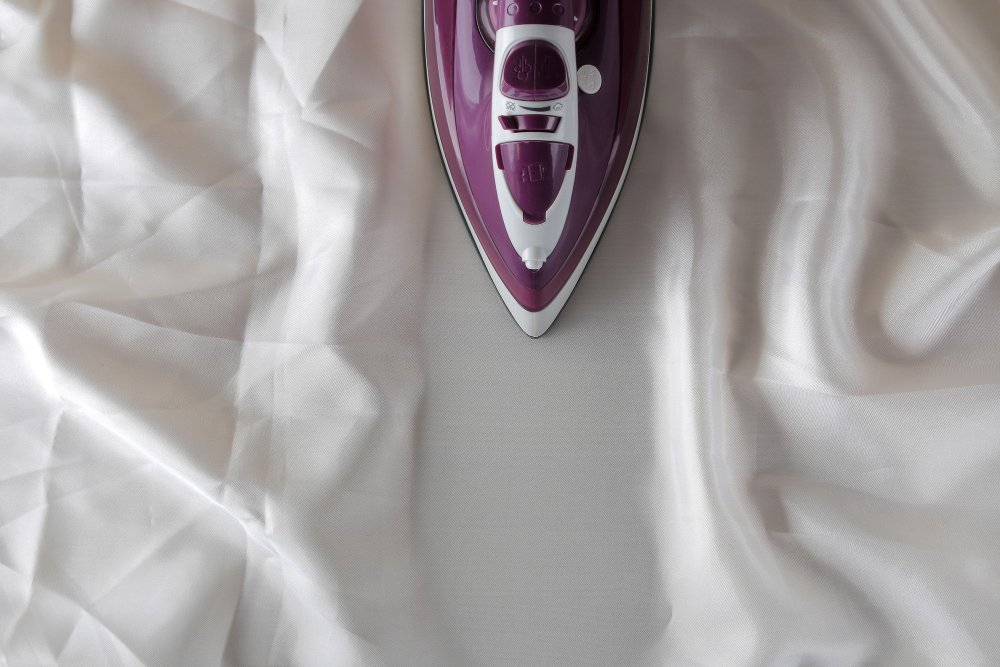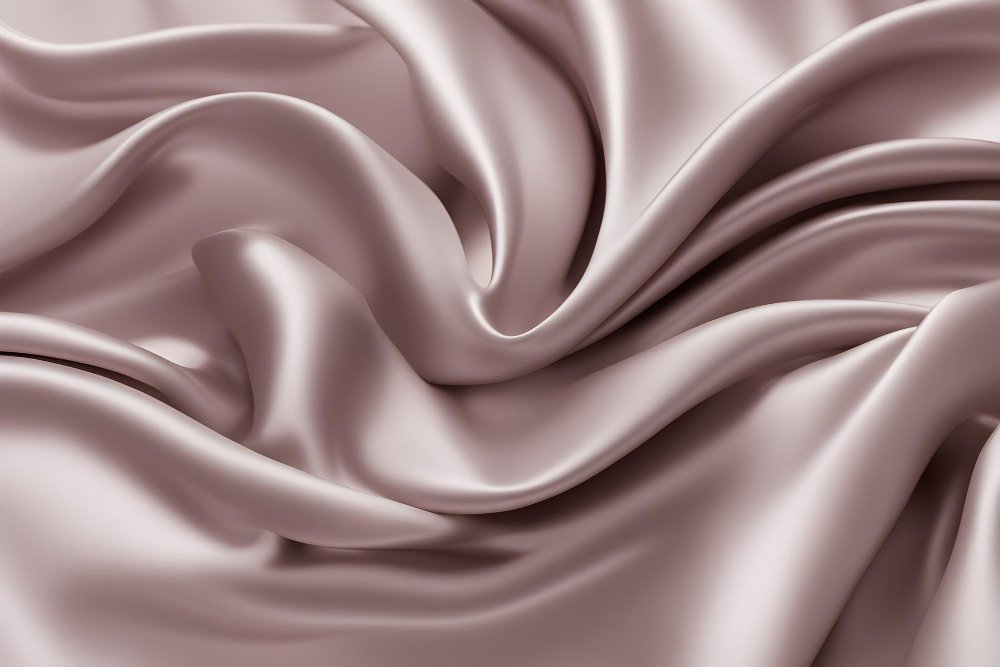Everything you need to know about charmeuse fabric, from its silky texture and care to sustainability and sewing tips
Run your fingers across charmeuse fabric and you’ll understand why it got its name from the French word “charmer.” The front surface feels like liquid silk, catching light with a beautiful shine, while the back stays soft and matte. This is the fabric that makes evening gowns flow like water, transforms bedding into a five-star hotel experience, and has been turning heads since ancient China.
But here’s what makes charmeuse different from other fancy fabrics: it’s not just about looking good. This fabric has real substance. Whether you’re a fashion lover hunting for the perfect bridal gown material, an eco-conscious shopper wondering about sustainable silk options, or a sewing enthusiast ready to tackle your next project, understanding charmeuse will open up a whole new world of possibilities.
Table of Contents
- What is Charmeuse Fabric?
- The Rich History of Charmeuse
- How Charmeuse Fabric is Made
- Types of Charmeuse Fabric
- Key Characteristics and Properties
- Sustainability and Ethical Production
- Uses and Applications
- Charmeuse vs Other Fabrics
- Complete Care Guide
- Sewing with Charmeuse
- Buying Guide
- Frequently Asked Questions
- Conclusion
What is Charmeuse Fabric?

Let’s clear up the confusion right away. Charmeuse is a type of fabric defined by how it’s woven, not what it’s made from. Think of it like this: “denim” describes the weave pattern, whether it’s made from cotton or a blend. Charmeuse works the same way.
Is Charmeuse Silk and Charmeuse Fabric the Same?
Not exactly. “Charmeuse” refers to the satin weave technique that creates that signature glossy front and matte back. “Silk charmeuse” means the fabric is made from real silk fibers. You can also have polyester charmeuse, rayon charmeuse, or even cotton-blend charmeuse. They all use the same weaving method but different materials.
Quick Answer: Charmeuse is the weave style. Silk is the fiber. Silk charmeuse is charmeuse fabric made from silk. You can have charmeuse without silk, but it won’t feel quite the same.
Is Charmeuse Silk Real Silk?
When you see “silk charmeuse” or “100% silk charmeuse,” yes, it’s real silk. The fabric is woven from actual silk fibers harvested from silkworm cocoons. But watch out for products labeled just “charmeuse” without mentioning silk-these are usually made from synthetic materials like polyester that copy the look and feel of silk at a lower price point.
The Technical Breakdown
Charmeuse uses a satin weave where the lengthwise threads (warp) float over four or more crosswise threads (weft). This creates that smooth, reflective surface on one side. The threads lie flat and parallel, which is why light bounces off so beautifully. On the flip side, the back shows more of the crosswise threads, giving it a duller, more textured look.
What makes charmeuse different from regular satin? Charmeuse typically uses a lighter weight and tighter thread count, making it more fluid and drapey. Regular satin can be heavier and stiffer. For more details on different silk fabric types, check out our complete guide.
The Rich History of Charmeuse
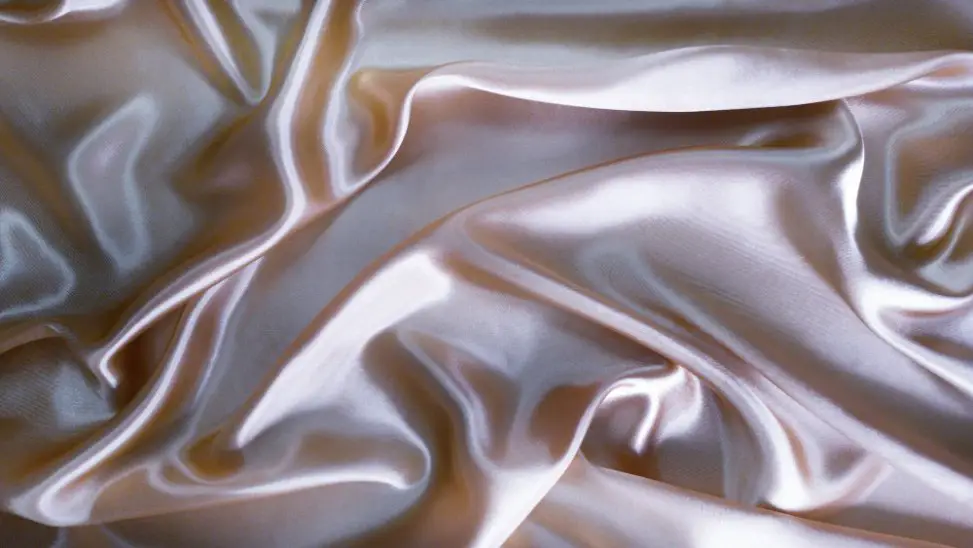
The story of charmeuse goes back thousands of years, starting in a place you might expect: ancient China.
Ancient Chinese Origins (3630 BC)
Silk production began in China around 3630 BC, making it one of humanity’s oldest luxury textiles. Early forms of charmeuse-like fabrics were reserved exclusively for Chinese royalty and nobility. Common citizens were actually forbidden from wearing silk-breaking this rule could mean serious punishment. Some historical records call early charmeuse “the fabric of emperors” because of its beauty and restricted access.
The Chinese guarded their silk-making secrets closely. For centuries, silk production remained a mystery to the rest of the world, and China controlled the entire market.
The Silk Road and Western Discovery
As trade routes expanded, particularly along the famous Silk Road, charmeuse and other silk fabrics made their way to Europe and the Middle East. Western traders and nobles quickly fell in love with silk’s unique properties. Throughout the Middle Ages and Renaissance, silk became the ultimate status symbol among European aristocracy.
French Refinement
The modern charmeuse we know today was further developed by French tailors and dressmakers, which explains the French name. “Charmeuse” comes from “charmeur,” meaning “charmer” or “seducer”-pretty fitting for a fabric that looks this good.
French artisans perfected the weaving technique, creating fabric that was lighter and more fluid than traditional satins. This made charmeuse perfect for the flowing gowns and elegant styles popular in French fashion.
Women’s Suffrage Connection
Here’s a cool piece of history: records show that American women wore charmeuse dresses to celebrate the successful passage of women’s suffrage in the United States. The fabric became associated with important social moments and celebrations.
20th Century and Synthetic Alternatives
During the 1900s, American and European companies developed synthetic fibers like polyester and rayon, partly to replace expensive silk. They marketed these as “silk alternatives” that were easier to produce and more affordable.
The catch? Synthetic charmeuse never quite matched the real thing. Silk has a unique softness and light-catching quality that polyester just can’t copy. That’s why silk charmeuse remains the gold standard today, even though synthetic versions exist.
How Charmeuse Fabric is Made
Understanding how charmeuse is made helps you appreciate why it costs what it does and why quality varies so much.
Silk Production: From Cocoon to Thread
For silk charmeuse, the process starts with sericulture-raising silkworms. Here’s how it works:
- Silkworm Cultivation: Silkworms (usually Bombyx mori) live on mulberry trees, eating mulberry leaves.
- Cocoon Formation: When ready to transform into moths, silkworms spin cocoons from a single continuous silk thread that can be up to 900 meters long.
- Harvesting: Workers collect the cocoons before the moths break through (which would damage the silk thread).
- Boiling and Unraveling: Cocoons are boiled to loosen the silk and killed the pupae inside. Workers then use brushes to find the loose ends.
- Reeling: The silk fibers are twisted together to create stronger threads, then wound onto reels.
- Spinning: Multiple silk threads are twisted together to create yarn strong enough for weaving.
Fun fact: It takes about 3,000 silk cocoons to produce just one yard of woven silk cloth.
The Satin Weave Process
Once the silk yarn is ready, weavers create charmeuse using a specialized satin weave on large looms:
- Warp threads (lengthwise) float over four or more weft threads (crosswise)
- This creates a smooth surface with minimal thread interruption
- The float pattern reflects light, creating that signature shine
- The tight weave gives charmeuse its characteristic drape
Finishing Processes
After weaving, charmeuse goes through finishing steps:
- Heat Setting: Stabilizes the fabric and sets its properties
- Dyeing: Colors the fabric (silk takes dye beautifully)
- Quality Control: Inspection for flaws or weak spots
Synthetic Charmeuse Production
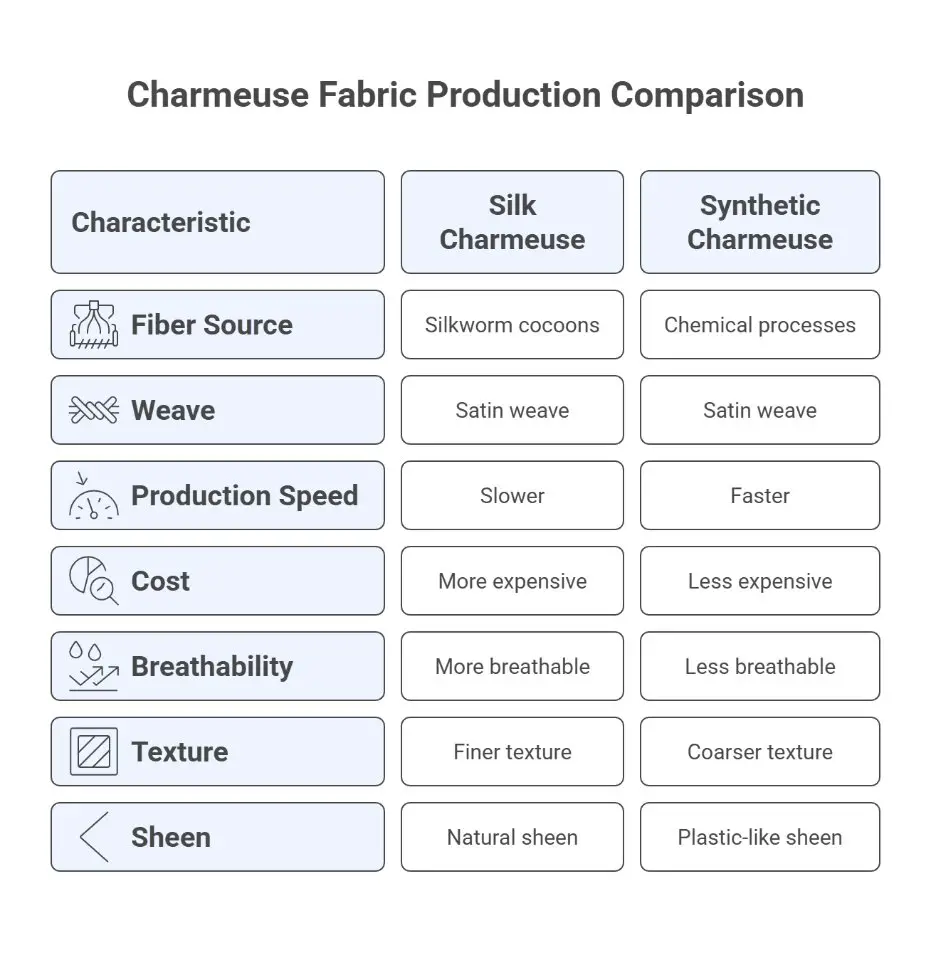
Polyester and rayon charmeuse start with chemical processes to create synthetic fibers. These fibers are then woven using the same satin weave pattern. The process is faster and cheaper but produces a fabric with different properties-less breathable, different texture, and a more plastic-like sheen compared to silk.
Types of Charmeuse Fabric
Not all charmeuse is created equal. Here’s what you need to know about the different types you’ll encounter.
Silk Charmeuse: The Original and Best

Made from 100% silk fibers, this is the most luxurious option. Silk charmeuse offers:
- Natural, soft sheen (not plastic-looking)
- Excellent breathability
- Temperature regulation (cool in summer, warm in winter)
- Hypoallergenic properties
- Smooth texture that’s gentle on skin and hair
- Beautiful drape and flow
The downside? It’s expensive, requires careful handling, and needs special care. Learn more about silk fabric properties to understand what makes it special.
Understanding Momme Weight
Silk charmeuse is measured in “momme” (pronounced “moe-mee”), a unit that describes the weight and thickness. The momme count tells you how heavy and durable the fabric is.
12-16 Momme
Lightweight and delicate
Best for: Scarves, linings, lightweight lingerie
19 Momme
Medium weight, most popular
Best for: Pillowcases, sleepwear, blouses, general clothing
22-25 Momme
Heavier and more durable
Best for: Bedding, dresses, items that need more structure
25-30 Momme
Heaviest silk charmeuse
Best for: High-end clothing, draperies, luxury bedding
Which is Better: 22 or 25 Momme Silk?
Both are high quality, but here’s the difference: 25 momme silk is heavier, more durable, and more expensive. It’s better for items that get heavy use like bedding. 22 momme offers an excellent balance of quality and comfort at a slightly lower price point. For pillowcases and clothing, many people prefer 19-22 momme because it’s lighter and more breathable.
Use our momme weight guide tool to find your perfect match.
Polyester Charmeuse
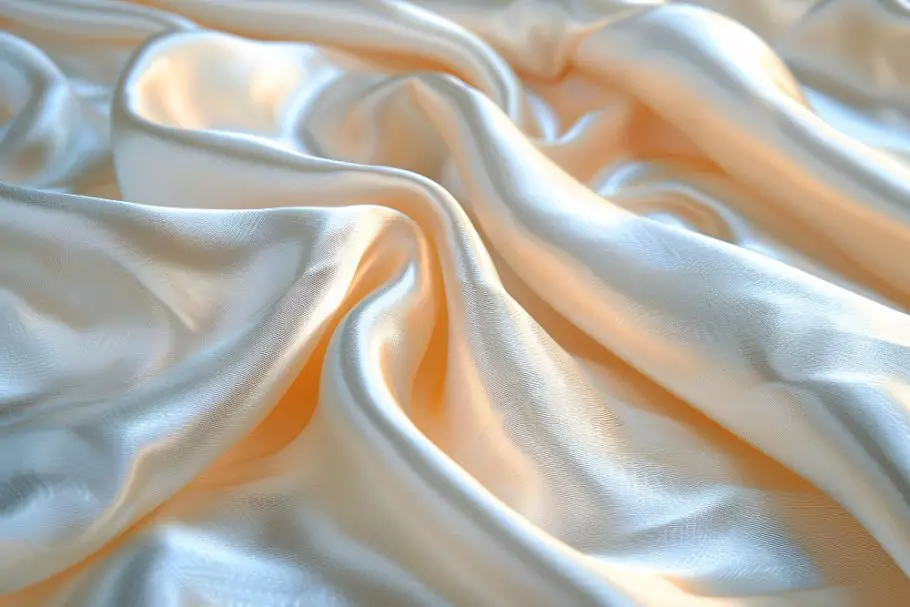
This synthetic alternative mimics silk’s appearance at a fraction of the cost. Polyester charmeuse:
- Much more affordable than silk
- More durable and resistant to damage
- Machine washable in many cases
- Doesn’t wrinkle as easily
- Available in bright, vivid colors
The trade-offs:
- Not breathable (can feel hot and sweaty)
- Less comfortable against skin
- Sheen looks more artificial
- Tends to pill and snag
- Not environmentally friendly
- Can pucker at seams when sewing
Rayon/Viscose Charmeuse

Rayon was specifically marketed as a silk alternative. It’s semi-synthetic (made from plant cellulose but heavily processed with chemicals).
- Softer than polyester
- Better drape than polyester
- More affordable than silk
- Better breathability than polyester
Downsides:
- Still doesn’t match silk’s feel
- Can be weak when wet
- May shrink significantly
- Requires careful washing
Cotton-Blend Charmeuse

Some manufacturers blend cotton with polyester to create a softer, more breathable alternative to pure synthetic charmeuse. This offers a middle ground between synthetic and natural fibers but doesn’t capture silk’s unique qualities.
Hemp-Silk Charmeuse Blends

This is an emerging sustainable option that combines organic hemp (typically 70%) with silk (30%). These blends offer:
- Better environmental profile than pure silk
- Durability from hemp fibers
- Some of silk’s luxurious feel
- Lower cost than 100% silk
Hemp-silk charmeuse is gaining popularity among eco-conscious consumers who want luxury with a smaller environmental footprint.
What is 100% Satin Charmeuse?
This term can be confusing. “Satin” refers to the weave, not the material. “100% satin charmeuse” usually means 100% polyester in a satin weave (charmeuse style). True silk charmeuse will be labeled “100% silk charmeuse” or “silk charmeuse.”
Key Characteristics and Properties
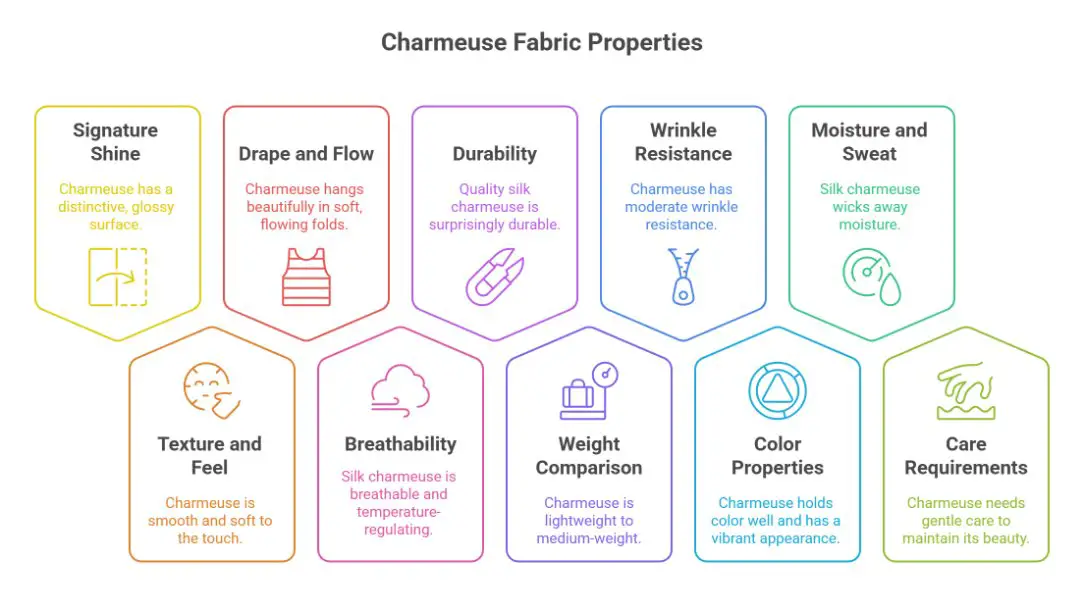
What makes charmeuse special? Let’s break down the features that set this fabric apart.
The Signature Shine
Is Charmeuse Silk Shiny?
Yes! That lustrous sheen is charmeuse’s defining feature. The satin weave creates a smooth surface that reflects light beautifully. Silk charmeuse has a soft, natural glow that looks luxurious without being too flashy. The sheen adds depth to colors and makes the fabric appear to shimmer when you move.
The shine differs from other fabrics: compared to sateen or regular satin, charmeuse has a more fluid, liquid-like gleam rather than a stiff, shiny appearance.
Texture and Feel
Is Charmeuse Silk Slippery?
Kind of. Charmeuse feels incredibly smooth and silky-that’s part of its appeal. It glides across your skin, which makes it comfortable to wear but also means:
- It can be slippery to work with when sewing
- Bedding made from charmeuse might feel slippery at first
- The fabric drapes and flows easily
- It doesn’t cling or stick to your body
This smoothness is actually beneficial for hair and skin-unlike cotton, charmeuse doesn’t create friction that causes hair tangles or sleep wrinkles.
Drape and Flow
Charmeuse is famous for its beautiful drape. The fabric hangs in soft, flowing folds rather than sticking out or holding a stiff shape. This makes it perfect for:
- Bias-cut dresses that hug your curves
- Flowing evening gowns
- Elegant blouses that move with you
- Luxurious curtains that pool on the floor
The lightweight nature of charmeuse contributes to this drape. It’s not stiff or structured-think fluid and graceful instead.
Breathability and Temperature Regulation
Silk charmeuse is naturally breathable and temperature-regulating. It’s an excellent insulator that:
- Keeps you cool in summer by wicking away moisture
- Keeps you warm in winter by trapping body heat
- Works well for year-round use
Polyester charmeuse? Not breathable at all. It traps heat and moisture, which is why synthetic charmeuse feels uncomfortable in warm weather.
Durability: Stronger Than You Think
Despite its delicate appearance, quality silk charmeuse is surprisingly durable when cared for properly. The tight weave and strong silk fibers mean it can last for years. However:
- It can snag easily if caught on rough surfaces
- Sharp objects or jewelry can pull threads
- Water spots can show on the fabric
- Direct sunlight can fade colors over time
Weight Comparison
Charmeuse is lightweight to medium-weight, depending on the momme count. It feels substantial enough to have good drape but light enough to be comfortable. Think of it as heavier than chiffon but lighter than taffeta.
Wrinkle Resistance
Does Charmeuse Silk Wrinkle Easily?
Silk charmeuse does wrinkle, but not as badly as you might think. It gets soft wrinkles and creases rather than sharp, permanent lines. The fabric tends to hang out wrinkles naturally when draped. Polyester charmeuse is more wrinkle-resistant but can develop creases that are harder to remove if the fabric is folded for long periods.
Does Charmeuse Wrinkle Easily?
Yes and no. During wear, charmeuse resists wrinkling fairly well because it drapes smoothly. But if you pack it tightly or fold it, you’ll get wrinkles. The good news: steam or light ironing easily removes these wrinkles (more on that in the care section).
Color Properties
What Colors Does Charmeuse Silk Come In?
Silk charmeuse comes in virtually any color you can imagine. Silk takes dye beautifully, producing rich, vibrant colors that look deeper and more dynamic than the same colors in synthetic fabrics. Popular options include:
- Classic whites, ivories, and creams (perfect for bridal wear)
- Deep jewel tones (emerald, sapphire, ruby)
- Soft pastels
- Bold brights
- Sophisticated neutrals (champagne, blush, gray, navy)
- Rich darks (black, burgundy, forest green)
The shine of charmeuse makes colors appear more dimensional-they shift and change as light hits the fabric from different angles.
Moisture and Sweat
Does Silk Charmeuse Show Sweat?
Silk charmeuse doesn’t show sweat stains as obviously as some fabrics, but water (including sweat) can leave spots on the fabric, especially on lighter colors. The good news: silk naturally wicks moisture away from your body, so you’re less likely to sweat heavily when wearing it. Dark colors hide any potential spotting better than light colors.
Care Requirements
Charmeuse needs gentle care to maintain its beauty. Silk charmeuse requires hand washing or dry cleaning, while polyester charmeuse can often handle machine washing. This is a major factor when deciding between silk and synthetic versions.
Sustainability and Ethical Production
If you care about the environmental and ethical impact of your clothing choices, understanding charmeuse production is important.
Traditional Silk Production: The Good
Traditional silk production has several environmental advantages:
- No Pesticides Needed: Since silkworms are the product (not a pest), using pesticides would be counterproductive
- No Synthetic Chemicals: The silk itself is a natural protein fiber
- Biodegradable: Silk breaks down naturally, unlike synthetic fabrics
- Mulberry Trees Don’t Need Fertilizer: They grow well without chemical inputs
- Byproducts Get Used: Mulberry fruits are eaten, wood is used for fuel, leaves feed cattle, lower-grade silk fills duvets
- Supports Traditional Communities: Silk farming provides livelihoods in rural Asia
The Ethical Concerns
Here’s the complicated part: traditional silk production kills the silkworms. The cocoons are boiled with the pupae inside to harvest the silk fibers. This bothers many people, especially those following vegan or animal-welfare principles.
Other concerns include:
- Worker exploitation in some silk-producing regions
- Low wages for silk workers
- Unsafe working conditions in some facilities
- Child labor in certain areas
Peace Silk (Ahimsa Silk): The Ethical Alternative
Peace silk, also called Ahimsa silk, addresses the ethical concerns. “Ahimsa” is a Sanskrit word meaning “non-violence.” In peace silk production:
- Silkworms complete their full life cycle
- Moths are allowed to emerge from cocoons naturally
- Only then is the silk harvested
- The worms aren’t killed
The catch: Peace silk costs more because the broken cocoons produce shorter silk fibers that require more processing. The resulting fabric has a slightly different texture-a bit more like raw silk.
Fair Trade and Ethical Certifications
Look for these certifications when buying silk charmeuse:
- Fair Trade Certified: Ensures fair wages and safe working conditions
- GOTS (Global Organic Textile Standard): Covers both environmental and social criteria
- OEKO-TEX Standard 100: Tests for harmful chemicals (commonly used for silk)
Sustainable Silk Alternatives
Hemp-Silk Blends
As mentioned earlier, hemp-silk charmeuse (typically 70% organic hemp, 30% silk) offers a more sustainable option:
- Hemp grows quickly with minimal water
- No pesticides needed
- Hemp enriches soil rather than depleting it
- Lower overall environmental impact
- Still gives you some silk’s luxurious qualities
Organic Silk
Some producers offer organic silk, which means:
- No synthetic hormones given to silkworms
- No chemical additives
- Low-impact dyes used
- Organic farming practices for mulberry trees
The Problem with Synthetic Charmeuse
While polyester and rayon charmeuse cost less, their environmental impact is much worse:
- Polyester: Made from petroleum, non-biodegradable, releases microplastics when washed
- Rayon/Viscose: Heavily processed with toxic chemicals, these chemicals often pollute waterways
- Both contribute to long-term environmental damage
- Neither breaks down naturally in landfills
Making Sustainable Choices
If sustainability matters to you:
- Choose Quality Over Quantity: One piece of good silk charmeuse will last longer than several cheap polyester versions
- Look for Certifications: OEKO-TEX, Fair Trade, GOTS
- Consider Peace Silk: If animal welfare is a concern
- Try Hemp-Silk Blends: Lower environmental impact
- Buy from Transparent Brands: Companies that share their production practices
- Care for It Properly: Making your charmeuse last longer is the most sustainable choice
Uses and Applications

Charmeuse’s versatility makes it popular in both fashion and home decor. Here’s where you’ll see this fabric shine (literally).
Fashion and Apparel
Evening Wear and Formal Dresses
Charmeuse is a top choice for elegant evening gowns because:
- The drape creates flattering silhouettes
- The shine catches light beautifully (perfect for photos)
- It flows gracefully when you move
- The fabric feels luxurious
You’ll often see charmeuse in slip dresses, bias-cut gowns, and formal evening wear.
Bridal and Special Occasion Wear
Many wedding dresses use silk charmeuse, especially for:
- Sleek, modern wedding gown styles
- Bias-cut bridal dresses
- Simple, elegant designs (charmeuse doesn’t need much embellishment)
- Bridesmaid dresses in matching colors
The fabric photographs beautifully and holds dye well for wedding color schemes.
Lingerie and Sleepwear
Charmeuse is popular for intimate apparel because it:
- Feels smooth against bare skin
- Doesn’t irritate sensitive skin
- Looks and feels luxurious
- Drapes beautifully for nightgowns and robes
- Helps regulate body temperature for comfortable sleep
Blouses and Tops
Charmeuse makes sophisticated blouses and tops for professional or dressy occasions. The fabric:
- Adds polish to any outfit
- Pairs well with suits and dress pants
- Comes in work-appropriate colors
- Feels comfortable during long wear
Skirts and Pants
While less common, charmeuse works for:
- Flowing maxi skirts
- Elegant wide-leg pants
- Slip skirts (the midi/maxi version of slip dresses)
The fabric doesn’t hold shape well, so it’s not great for structured styles like pleated skirts or tailored pants.
Linings
Charmeuse makes excellent lining for:
- Jackets and coats
- Wool garments
- Pants and skirts
The smooth surface makes clothes easy to slip on and off, and it feels nice against your skin or over other clothing.
Accessories
Silk charmeuse appears in:
- Scarves and wraps
- Ties and bow ties
- Pocket squares
- Headbands and hair accessories
Home Decor and Bedding
Luxury Bedding

Charmeuse has become increasingly popular for bedding, especially:
- Pillowcases: The smooth surface reduces friction, helping prevent hair tangles, split ends, and sleep wrinkles
- Sheets: Feel luxurious and help regulate body temperature
- Duvet Covers: Add elegance to your bedroom
For bedding, look for 19-25 momme silk charmeuse for the right balance of durability and comfort.
Curtains and Draperies
Charmeuse makes stunning window treatments:
- The drape creates elegant folds
- The sheen adds visual interest
- Light filtering creates beautiful effects
- Available in custom colors to match decor
Decorative Pillows
Charmeuse pillow covers add a touch of luxury to living spaces. They work well as accent pieces mixed with other textures.
Table Linens
For special occasions, charmeuse table runners and napkins create an elegant table setting. The fabric drapes beautifully and photographs well for events.
Charmeuse vs Other Fabrics
Understanding how charmeuse compares to similar fabrics helps you choose the right material for your needs.
What is the Difference Between Silk Satin and Charmeuse?

This is one of the most common questions. Here’s the deal: “satin” refers to a weaving technique, not a specific fabric. Both charmeuse and satin use a satin weave, but:
| Feature | Charmeuse | Regular Satin |
|---|---|---|
| Weight | Lighter, more fluid | Can be heavier and stiffer |
| Drape | Flows beautifully, very drapey | May hold shape more, less drape |
| Float Ratio | Different weave ratio | Standard satin weave |
| Feel | Softer, more supple | Can feel more structured |
| Best For | Flowing garments, bias cuts, draping | Structured garments, fuller skirts |
Think of charmeuse as a specific, lighter type of satin. All charmeuse is satin-weave, but not all satin is charmeuse.
Is Charmeuse Thicker Than Satin?
No, typically the opposite. Charmeuse is usually thinner and lighter than regular satin. That’s why it drapes so well.
Charmeuse vs Mulberry Silk

What is the Difference Between Charmeuse Silk and Mulberry Silk?
This is comparing apples to oranges. Here’s why:
- Mulberry Silk: The type of silk (the raw material). It comes from Bombyx mori silkworms that eat mulberry leaves. It’s the highest quality silk available.
- Charmeuse: A weaving method that creates a specific fabric style.
Silk charmeuse is usually made FROM mulberry silk. So you’d have “mulberry silk woven in a charmeuse style” or “mulberry silk charmeuse.” They work together, not against each other.
Other types of silk (like tussah or wild silk) can also be woven into charmeuse, but mulberry silk makes the finest quality charmeuse.
Charmeuse vs Habotai

Both are silk fabrics, but quite different:
| Feature | Charmeuse | Habotai |
|---|---|---|
| Weave | Satin weave | Plain weave |
| Shine | Very shiny on one side | Subtle sheen on both sides |
| Texture | Smooth, slippery | Slightly crisp, lighter |
| Weight | Medium | Lightweight |
| Price | More expensive | More affordable |
| Best For | Formal wear, luxury items | Linings, scarves, beginner projects |
Learn more about habotai silk and when to choose it over charmeuse.
Charmeuse vs Crepe de Chine

Both are popular silk fabrics with different looks:
| Feature | Charmeuse | Crepe de Chine |
|---|---|---|
| Surface | Smooth, glossy | Slightly pebbled, matte |
| Shine | High shine | Subtle luster |
| Drape | Fluid, flowing | Good drape with more body |
| Formal vs Casual | More formal looking | Versatile, can be casual |
| Care | Requires careful handling | Slightly easier to care for |
Crepe de Chine is a good alternative if you want silk without the high shine.
Charmeuse vs Chiffon
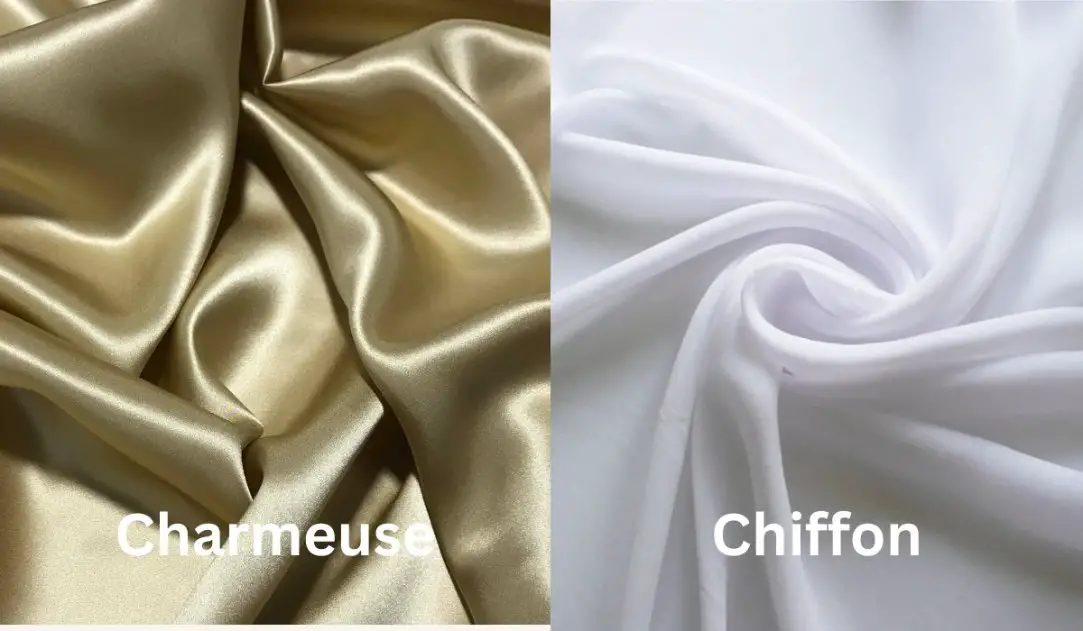
Very different silk fabrics:
| Feature | Charmeuse | Chiffon |
|---|---|---|
| Weight | Medium-weight | Very lightweight |
| Transparency | Opaque | Sheer, see-through |
| Texture | Smooth, slippery | Slightly rough, airy |
| Drape | Flows close to body | Floats away from body |
| Best For | Structured elegance | Ethereal, romantic looks |
Check out our chiffon guide if you want that airy, floating look instead.
Charmeuse vs Organza
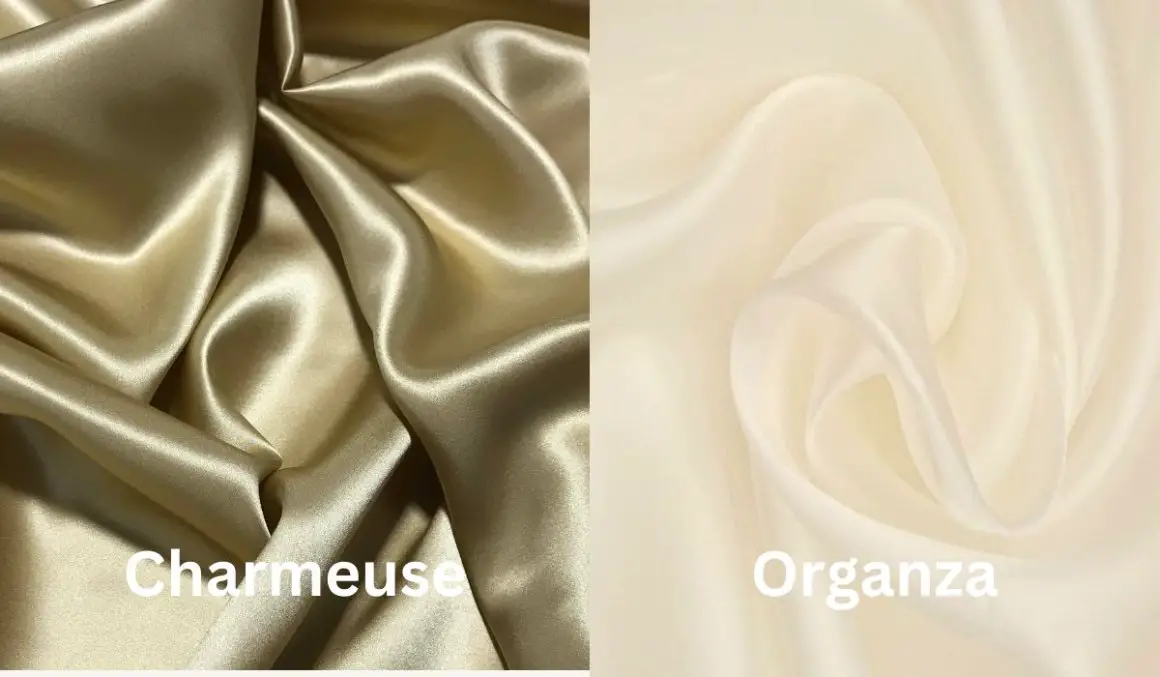
Another comparison of opposites:
- Charmeuse: Soft, drapey, smooth, flowing
- Organza: Crisp, stiff, sheer, holds shape
Organza is better for structured designs and adding volume. Charmeuse is better for elegant draping.
Charmeuse vs Georgette

Georgette sits between charmeuse and chiffon:
- Lighter than charmeuse but heavier than chiffon
- Slightly sheer (unlike opaque charmeuse)
- Has a crepe texture (unlike smooth charmeuse)
- Good drape but more structure than charmeuse
Charmeuse vs Velvet

These couldn’t be more different:
- Charmeuse: Smooth, glossy, lightweight, slippery
- Velvet: Plush, soft pile, heavy, absorbs light
Velvet is better for structure and winter wear. Charmeuse is better for flow and year-round comfort.
Silk Charmeuse vs Polyester Charmeuse
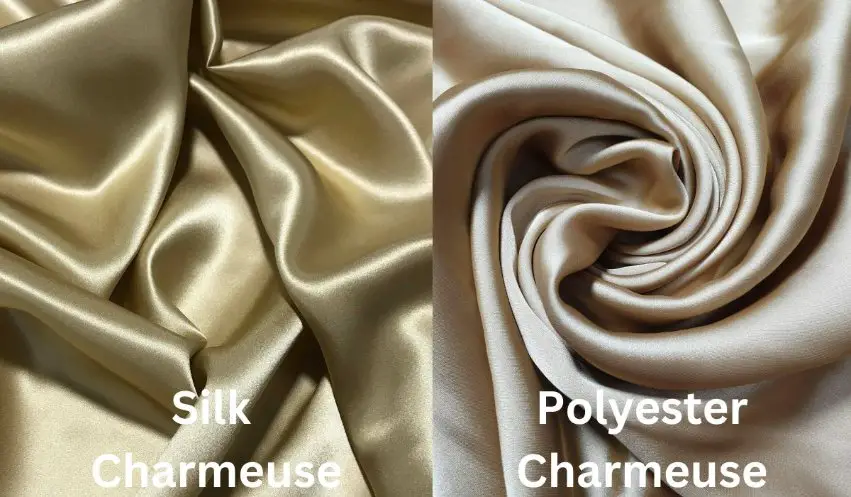
This is probably the most important comparison for buyers:
| Feature | Silk Charmeuse | Polyester Charmeuse |
|---|---|---|
| Price | $40-150+ per yard | $5-20 per yard |
| Feel | Soft, natural, luxurious | Slippery, synthetic, plasticky |
| Breathability | Excellent | Poor (traps heat and moisture) |
| Shine | Natural, soft glow | Artificial, more plastic-like |
| Durability | Good with proper care | More resistant to damage |
| Wrinkles | Wrinkles but easy to steam out | More wrinkle-resistant |
| Care | Hand wash or dry clean | Machine washable |
| Environmental Impact | Biodegradable, natural | Petroleum-based, releases microplastics |
| Best For | Luxury items, comfort, quality | Costumes, budget projects, practice |
Use our fabric comparison tool to see how different materials stack up for your specific needs.
Complete Care Guide
Proper care keeps your charmeuse looking beautiful for years. The care method depends on whether you have silk or synthetic charmeuse.
Can You Wash Silk Charmeuse?
Yes! Despite what many people think, you can wash silk charmeuse at home. It just requires gentle handling.
Hand Washing Silk Charmeuse (Best Method)
Hand washing is the safest way to clean silk charmeuse:
- Fill a Basin: Use cool or lukewarm water (never hot-it can damage silk)
- Add Gentle Detergent: Use a silk-specific detergent or gentle baby shampoo. Avoid regular laundry detergent with harsh enzymes.
- Submerge and Swish: Gently move the fabric through the water. Don’t scrub, twist, or wring.
- Soak Briefly: Let it sit for 3-5 minutes (no longer)
- Rinse Thoroughly: Use cool water until all soap is gone. Any leftover detergent can leave spots.
- Remove Excess Water: Gently press (don’t wring!) or roll in a clean, white towel to absorb water
- Dry Flat: Lay flat on a clean towel away from direct sunlight or heat
Machine Washing (When Possible)
Some silk charmeuse can be machine washed if you’re very careful:
- Use a mesh laundry bag
- Select delicate/hand wash cycle
- Use cold water only
- Use gentle silk detergent
- Remove immediately when done
- Never put in the dryer
Warning: Always test a small, hidden area first if you’re unsure. Some dyes can run or fade with washing.
Dry Cleaning
Professional dry cleaning is the safest option, especially for:
- Expensive or precious items
- Structured garments with lining
- Dark colors (less likely to fade)
- Items you’re unsure about
Drying Silk Charmeuse
Never put silk charmeuse in the dryer. The heat will damage the fibers and can cause shrinking.
Instead:
- Lay flat on a clean, dry towel
- Reshape gently while damp
- Keep away from direct sunlight (can fade colors)
- Avoid hanging wet silk (the weight can stretch it)
- Air dry completely before wearing or storing
Does Silk Charmeuse Shrink?
Silk charmeuse can shrink if exposed to:
- Hot water (always use cool or lukewarm)
- High heat from dryers
- Agitation from washing machines
Typical shrinkage is around 5% if cared for properly. Some shrinkage is normal after the first wash-that’s why many people pre-wash silk fabric before sewing.
Ironing and Steaming
How to Get Wrinkles Out of Silk Charmeuse
The best way to remove wrinkles is steaming:
- Hang the garment
- Use a handheld steamer or steam from your shower
- Hold steamer a few inches away
- Let the fabric relax naturally
Can You Steam Silk Charmeuse?
Yes! Steaming is actually the preferred method for silk charmeuse. It’s gentler than ironing and reduces the risk of damage or water spots.
If you must iron:
- Turn garment inside out
- Use the lowest heat setting (silk setting if available)
- Never iron on the shiny side
- Iron while slightly damp, or use a pressing cloth
- Don’t sprinkle water directly on silk (causes spots)
- Keep the iron moving-don’t let it sit
Stain Removal
How to Clean Charmeuse Silk Stains
Act fast when stains happen:
- Blot (Don’t Rub): Gently dab the stain with a clean, white cloth
- Test First: Test any cleaning method on a hidden seam
- For Fresh Stains: Try cool water with a tiny bit of gentle soap
- For Stubborn Stains: Take to a professional dry cleaner
Avoid:
- Bleach or harsh chemicals
- Rubbing or scrubbing
- Hot water
- Color-removing products
Storage Tips
Proper storage protects your investment:
- Clean Before Storing: Stains can set over time
- Use Padded Hangers: Wire hangers can create creases
- Or Fold Carefully: If folding, use tissue paper between folds to prevent creases
- Breathable Storage: Use cotton garment bags, not plastic (silk needs air)
- Avoid Moth Damage: Use cedar blocks or lavender sachets
- Keep Away From: Direct sunlight, heat, moisture
Caring for Polyester Charmeuse
Polyester charmeuse is much easier to care for:
- Machine wash on gentle cycle
- Use cold or warm water (avoid hot)
- Can tumble dry on low heat (though air drying is better)
- Iron on low to medium heat if needed
- More resistant to stains and wrinkles
However, polyester charmeuse can develop static cling and may pill over time with heavy washing.
For more detailed guidance, check our comprehensive silk care guide or use the silk care calculator for personalized instructions.
Sewing with Charmeuse
Charmeuse has a reputation for being tricky to sew. Let’s break down what you need to know to work with this fabric successfully.
Is Silk Charmeuse Hard to Sew?
It can be challenging, especially for beginners. The main issues are:
- Fabric is slippery and shifts easily
- Can be hard to control under the presser foot
- Pins can leave permanent holes
- Seams may pucker if not sewn carefully
- Fabric frays at cut edges
That said, with the right techniques and tools, even intermediate sewers can successfully work with charmeuse. It’s not recommended as a first project, but it’s definitely achievable.
What Needle to Use with Charmeuse?
The right needle makes a huge difference:
- Size: 60/8 to 70/10 (smaller needles for lightweight silk)
- Type: Microtex/sharp needles work best-they have a very sharp, fine point that pierces cleanly
- Why It Matters: Dull or thick needles can snag fibers or leave visible holes
- Replace Often: Change needles frequently when sewing silk-a slightly dull needle can damage the fabric
What is the Best Stitch for Charmeuse Satin?
For sewing seams in charmeuse:
- Straight Stitch: 2mm or shorter length (12-15 stitches per inch)
- Why Short Stitches: Prevents puckering and provides better control
- Tension: Reduce upper thread tension slightly to prevent puckering
- Speed: Sew slowly for better control
What Thread to Use with Charmeuse?
Thread choice affects your final results:
- Fine Silk Thread: Best option-blends seamlessly with silk fabric
- Fine Polyester Thread: Good alternative, more affordable and stronger
- Cotton Thread: Avoid-too thick and bulky for delicate fabric
- Match Color Carefully: Stitches show more on smooth fabric
For more guidance on thread selection, visit our thread selection guide.
Essential Sewing Techniques for Charmeuse
Cutting
- Use Very Sharp Scissors or Rotary Cutter: Dull blades snag and pull
- Single Layer Cutting: Cut one layer at a time for accuracy
- Use Weights Instead of Pins: Pins can leave permanent marks
- Sizing Spray: A light spray of fabric sizing can temporarily stiffen the fabric for easier cutting and handling
Preventing Slipping
- Walking Foot: This presser foot feeds top and bottom layers evenly
- Tissue Paper Method: Place tissue paper under the fabric while sewing, then tear it away
- Stay Stitching: Sew a line of stitching just inside the seam allowance to stabilize edges
Pinning Alternatives
Since pins can damage charmeuse:
- Use fine silk pins only (if you must pin)
- Pin within the seam allowance only
- Try clothespins or clips at edges
- Consider hand basting instead of pinning
Seam Finishes
Because charmeuse frays easily, finish seams properly:
- French Seams: Best option-encloses raw edges beautifully, perfect for sheer or lightweight fabrics
- Flat-Felled Seams: Strong and neat, good for pajamas or robes
- Serged/Overlocked Edges: If you have a serger, this works well
- Hong Kong Finish: Bias binding that encloses raw edges elegantly
Preventing Puckering
- Reduce upper tension on your machine
- Use short stitch length (2mm)
- Hold fabric taut (but don’t pull) as you sew
- Sew slowly and steadily
- Test on scrap fabric first
Pressing While Sewing
Pressing as you sew helps achieve professional results:
- Press seams open (rather than to one side) to reduce bulk
- Use a pressing cloth to protect the fabric
- Press on the wrong (matte) side
- Use low heat and steam
- Press gently-don’t slide the iron
Best Patterns for Charmeuse
Charmeuse works best with certain pattern styles:
- Good Choices: Slip dresses, bias-cut garments, flowing blouses, simple nightgowns, loose pajama pants, draped cowl necks
- Avoid: Structured jackets, pleated skirts, anything with lots of gathering, garments with many pieces, tight-fitting styles
Look for patterns that specifically recommend charmeuse, satin, or “drapey fabrics.”
Practice First
Before cutting into expensive silk charmeuse:
- Buy a small amount of polyester charmeuse to practice
- Test your machine settings
- Try different needles and threads
- Practice seam finishes
- Get comfortable with the fabric’s behavior
Buying Guide: How to Choose Quality Charmeuse
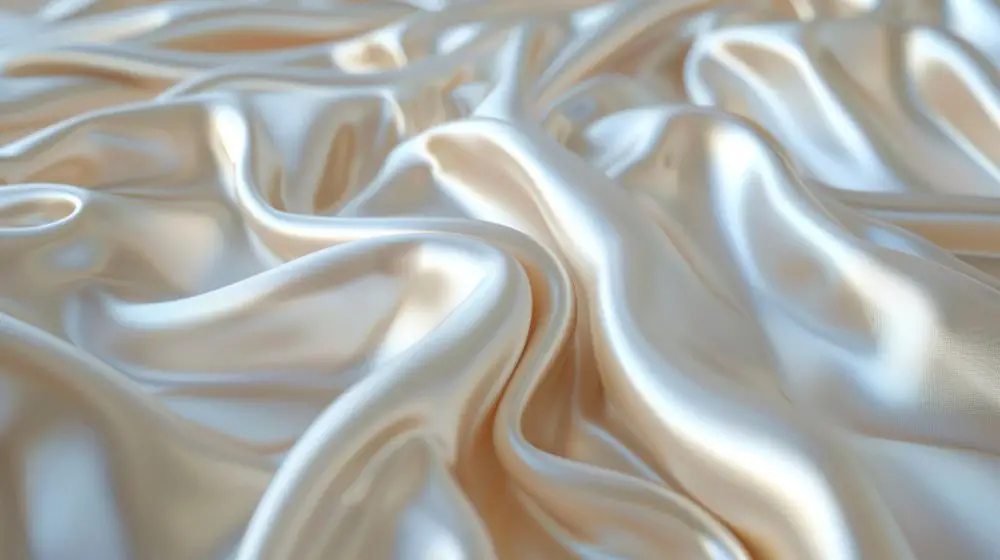
Not all charmeuse is created equal. Here’s how to spot quality fabric and avoid wasting money on inferior products.
Is Charmeuse High Quality?
It depends! “Charmeuse” just describes the weave type. Quality varies based on:
- Fiber content (silk vs synthetic)
- Momme weight (for silk)
- Weave tightness
- Manufacturing quality
- Origin of production
Silk charmeuse from reputable suppliers is definitely high quality. Cheap polyester charmeuse is not.
How to Identify Real Silk Charmeuse
Is Charmeuse Silk Real?
Only if it’s labeled “silk charmeuse” or “100% silk.” Here’s how to verify:
- Burn Test: Real silk burns slowly, smells like burning hair, and turns to ash. Synthetic silk melts into a plastic ball and smells like chemicals.
- Touch Test: Silk feels warmer to touch initially (it’s a good insulator). Polyester feels cool and plastic-like.
- Shine Test: Silk has a soft, natural shimmer. Polyester has a more artificial, plastic shine.
- Scrunch Test: Silk springs back with less wrinkles. Polyester holds creases longer.
- Price Test: Real silk charmeuse costs $40+ per yard. If it’s $10/yard, it’s probably polyester.
Use our silk identification quiz to test your knowledge.
Understanding Momme Weight for Your Project
| Momme | Weight | Best Uses | Price Range |
|---|---|---|---|
| 12-14 | Very light | Linings, lightweight scarves | $ |
| 16 | Light | Scarves, lightweight lingerie, pillowcases | $$ |
| 19 | Medium | Most popular-blouses, pajamas, pillowcases, light dresses | $$ |
| 22 | Medium-heavy | Dresses, bedding, drapes, quality clothing | $$$ |
| 25 | Heavy | Luxury bedding, durable garments, high-end items | $$$$ |
| 30 | Very heavy | Heavy draperies, luxury bedding, special occasion wear | $$$$ |
What is 19 Momme Charmeuse Silk?
This is the most popular weight for general use. 19 momme silk charmeuse offers the best balance of:
- Durability for regular use
- Soft, comfortable feel
- Beautiful drape
- Reasonable price
- Versatility for various projects
Most people choose 19 momme for pajamas, blouses, and pillowcases because it works well without being too expensive or too delicate.
Price Expectations
Understanding typical prices helps you spot deals and avoid scams:
- Silk Charmeuse (19-22 momme): $40-80 per yard
- High-End Silk Charmeuse (25+ momme): $80-150+ per yard
- Italian Silk Charmeuse: Premium prices, often $100+ per yard
- Polyester Charmeuse: $5-20 per yard
- Hemp-Silk Blend: $30-50 per yard
Remember: you get what you pay for with charmeuse. Extremely cheap “silk” is almost certainly polyester.
Where to Buy Quality Charmeuse
Regional Quality Differences
Where charmeuse is produced affects quality and price:
- Italy: Known for highest quality silk and superior dyeing techniques. Premium prices.
- China: Original home of silk, excellent quality available. Wide price range depending on grade.
- India: Good quality, often more affordable. Rich color options.
- France: Historical silk production, luxury fabrics. Very expensive.
Online vs In-Store
In-Store Advantages:
- Can touch and feel fabric
- See true colors
- Get expert advice
- No shipping costs
Online Advantages:
- Wider selection
- Often better prices
- Can order samples first
- Read customer reviews
Red Flags to Avoid
Watch out for these warning signs:
- Unclear Fiber Content: If it doesn’t explicitly say “100% silk” or “silk charmeuse,” it’s probably synthetic
- Too-Good-To-Be-True Prices: Real silk doesn’t cost $15/yard
- No Momme Information: Reputable sellers always list momme weight for silk
- Poor Reviews: Check reviews for comments about quality issues
- Vague Country of Origin: Quality sellers list where fabric is made
Questions to Ask Sellers
Before buying, ask:
- What is the exact fiber content?
- What is the momme weight? (for silk)
- Where was it manufactured?
- Is it pre-washed or will it shrink?
- Can I order a sample first?
- What is your return policy?
- Are there any certifications? (OEKO-TEX, etc.)
Ordering Samples
For expensive fabric, always order samples first:
- Test the hand feel and drape
- Verify color matches your expectations
- Check quality and weight
- Test care requirements
- Much cheaper than buying yards of wrong fabric
Frequently Asked Questions
Yes, charmeuse is excellent for specific uses. Silk charmeuse is a high-quality luxury fabric perfect for evening wear, bridal gowns, lingerie, and bedding. It’s beautiful, comfortable, breathable, and gentle on skin and hair. However, it requires careful handling and isn’t suitable for everyday casual wear or items that need structure. Polyester charmeuse is good for budget-conscious projects but doesn’t match silk’s quality or comfort.
When labeled “silk charmeuse” or “100% silk charmeuse,” yes, it’s pure silk made from silkworm fibers. However, charmeuse can also be made from synthetic materials like polyester. Always check the label for fiber content-if it just says “charmeuse” without mentioning silk, it’s likely synthetic. Pure silk charmeuse is more expensive but offers far superior quality, feel, and performance compared to synthetic versions.
Charmeuse silk offers many benefits: it’s naturally hypoallergenic and gentle on sensitive skin, reduces friction that causes hair tangles and sleep wrinkles, regulates temperature for year-round comfort, drapes beautifully for flattering garments, has a luxurious shine and soft feel, is surprisingly durable with proper care, and is environmentally friendly compared to synthetic fabrics. It’s also moisture-wicking and breathable, making it comfortable in various climates.
Silk charmeuse can show water spots, including sweat, especially on lighter colors. However, silk naturally wicks moisture away from your body and is breathable, so you’re less likely to sweat heavily when wearing it compared to synthetic fabrics. Dark colors hide any potential spotting better than light colors. If sweating is a concern, choose darker shades and ensure proper ventilation. The moisture-wicking properties actually make silk charmeuse a good choice for people who tend to get warm.
Yes, silk charmeuse is considered high-quality luxury fabric, especially when it’s 19 momme or higher and made from mulberry silk. The quality depends on several factors: momme weight (higher is more durable), manufacturing origin (Italian and high-grade Chinese silk are top quality), weave tightness, and whether it’s made from genuine silk versus synthetic fibers. Always check for proper certifications like OEKO-TEX and verify you’re buying from reputable sellers to ensure you’re getting true quality silk charmeuse.
Silk charmeuse typically costs $40-80 per yard for 19-22 momme weight, while premium silk (25+ momme) runs $80-150+ per yard. Italian silk charmeuse often exceeds $100 per yard. Polyester charmeuse is much more affordable at $5-20 per yard. Hemp-silk blends fall in between at $30-50 per yard. Prices vary based on quality, origin, and seller. If you see “silk” charmeuse priced under $30 per yard, it’s likely low quality or not genuine silk.
Yes, but steaming is better. If you must iron silk charmeuse, turn the garment inside out, use the lowest heat setting (silk setting), and iron the matte side only-never the shiny side. Use a pressing cloth for extra protection and keep the iron moving. Don’t sprinkle water directly on silk as it causes spots. Iron while the fabric is slightly damp or use steam. For best results, hang the garment and steam it instead, holding the steamer a few inches away from the fabric.
Satin is a weaving technique, while charmeuse is a specific type of satin-weave fabric. All charmeuse is satin, but not all satin is charmeuse. Charmeuse is typically lighter weight, more fluid, and drapier than regular satin. It uses a different float ratio in the weave and is generally thinner. Charmeuse is often made from silk and has a softer, more supple feel compared to stiffer satin fabrics. Think of charmeuse as a refined, lighter version of satin specifically designed for draping.
Hand wash silk charmeuse in cool or lukewarm water with gentle silk detergent. Gently swish the fabric without scrubbing, twisting, or wringing. Rinse thoroughly until all soap is removed. Press (don’t wring) to remove excess water or roll in a clean towel. Lay flat to dry away from direct sunlight and heat. Never use hot water or put in the dryer. For valuable items, professional dry cleaning is safest. Some silk charmeuse can be machine washed on delicate cycle in a mesh bag, but always test first and follow care labels.
No, polyester charmeuse is not better than silk for quality, comfort, or environmental impact. Polyester is cheaper, more durable, easier to care for, and more wrinkle-resistant-these are its advantages. However, silk charmeuse is breathable (polyester isn’t), more comfortable against skin, has a natural soft sheen (not plastic-looking), regulates temperature, is biodegradable, and simply feels more luxurious. Choose polyester for budget projects, costumes, or practice pieces. Choose silk when quality, comfort, and luxury matter.
Charmeuse works best for projects that showcase its beautiful drape and shine. Ideal uses include: slip dresses and bias-cut gowns, evening wear and formal dresses, bridal gowns and bridesmaid dresses, lingerie and nightgowns, flowing blouses and elegant tops, pajamas and robes, luxury pillowcases and bedding, scarves and accessories, and garment linings. Avoid using charmeuse for structured garments, pleated skirts, tailored jackets, or anything that needs to hold a stiff shape. It’s not suitable for everyday casual wear or items that see heavy use without careful handling.
Silk charmeuse can snag if caught on rough surfaces, jewelry, or sharp objects, but it doesn’t typically pill. The smooth surface is vulnerable to pulls, so handle carefully and avoid catching it on zippers, Velcro, or rough textures. Remove jewelry that might catch threads before wearing charmeuse garments. Store carefully to prevent snagging. Polyester charmeuse is more resistant to snagging but may pill over time with heavy washing and wear. Quality silk charmeuse that’s well-cared for can last many years without significant damage.
Conclusion
Charmeuse fabric represents the perfect meeting point of beauty and function-when you choose the right type for your needs. Whether you’re drawn to its liquid-like drape, its gorgeous shine, or its skin-friendly properties, understanding what makes charmeuse special helps you make smart choices.
Key Takeaways
Remember the Fundamentals:
- Charmeuse is a weaving technique, not a specific fiber-you can have silk charmeuse, polyester charmeuse, or blended versions
- Silk charmeuse offers unmatched quality but requires gentle care and costs more
- Synthetic charmeuse is budget-friendly and easier to care for but doesn’t match silk’s comfort or environmental profile
- Momme weight matters for silk-19 momme is the sweet spot for most uses, while 22-25 momme works better for bedding and high-use items
Choose Silk Charmeuse When:
- Quality and comfort are your top priorities
- You’re making special occasion garments, bridal wear, or luxury items
- You want natural, breathable fabric for bedding or sleepwear
- You’re concerned about environmental impact and want a biodegradable option
- You’re willing to invest in proper care and handling
Choose Synthetic Charmeuse When:
- Budget is your main concern
- You’re making costumes, practice pieces, or projects where durability matters more than luxury
- You need easy-care fabric that can handle machine washing
- You’re learning to sew with slippery fabrics and don’t want to risk expensive silk
Smart Shopping Recommendations
Before you buy, ask yourself:
- What’s your project? Evening wear needs quality silk, while a Halloween costume can use polyester.
- What’s your budget? Be realistic about what you can spend-good silk charmeuse isn’t cheap, but it’s worth it for the right project.
- What’s your skill level? Beginners should practice with affordable polyester before cutting into expensive silk.
- How will you care for it? Make sure you’re willing to hand wash or dry clean before committing to silk.
- What matters most? Comfort? Appearance? Durability? Environmental impact? Let your priorities guide your choice.
Sustainability Matters
If you care about your environmental footprint, silk charmeuse wins over synthetic options-but consider going further:
- Look for peace silk if animal welfare concerns you
- Choose organic silk or hemp-silk blends when possible
- Verify fair trade certifications to ensure ethical production
- Buy quality over quantity-one well-made silk piece beats multiple cheap synthetic items
- Care for your charmeuse properly to make it last years or even decades
Care Is Non-Negotiable
Whatever type of charmeuse you choose, proper care determines how long it lasts and how good it looks. For silk charmeuse:
- Commit to gentle hand washing or professional dry cleaning
- Store properly in breathable garment bags
- Steam instead of iron when possible
- Handle carefully to avoid snags and pulls
- Keep away from direct sunlight during storage
The effort you put into care pays off in longevity-quality silk charmeuse can last a lifetime with proper treatment.
Final Recommendation
If you’re on the fence about trying charmeuse, start small. Order a sample or buy enough fabric for a simple project like a pillowcase or scarf. Experience the fabric firsthand-feel its drape, see how light plays across the surface, notice how comfortable it is against your skin. That hands-on experience will tell you more than any article can.
For those ready to invest in quality silk charmeuse, it’s a decision you won’t regret. Yes, it costs more. Yes, it requires careful handling. But the beauty, comfort, and longevity of genuine silk charmeuse make it worth every penny for the right projects.
Whether you’re sewing a wedding dress, upgrading your bedding, or simply appreciating fine fabrics, charmeuse offers something special. It’s fabric with history, character, and undeniable appeal-truly worthy of its name: the charmer.
Need More Help? Explore our complete collection of silk fabric guides, use our silk selector quiz to find your perfect match, or try our yardage calculator to plan your project.

